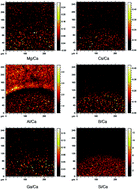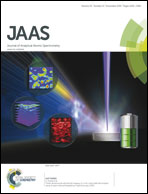Elemental fractionation during condensation of plasma plumes generated by laser ablation: a ToF-SIMS study of condensate blankets†
Abstract
Ion imaging of the condensate blanket around a laser ablation site provides a window to study elemental fractionation during condensation of a plasma plume. Here we used a Time-of-Flight Secondary Ion Mass Spectrometer (ToF-SIMS) to conduct depth profiling of the condensate blanket produced by excimer 193 nm laser ablation of NIST 610 glass. Compositional zonings (Ca normalized) revealed by ToF-SIMS are associated with texture gradients in the condensate blanket, as characterized by Secondary Electron Microprobe (SEM) images. Elements that are more volatile than Ca are relatively enriched in the inner zones (proximal to the ablation site) while more refractory elements are variable in their distributions. Volatility and ionization potential exert influence on elemental fractionation in plasma plume condensation processes as documented by the contrasting fractionation behaviors of alkaline and alkaline earth metals. Compositional zonings in the condensate blanket are due to physical and chemical zonings (e.g., temperature, pressure, electron density, speciation, etc.) within the condensing plume as it expands and cools. Zoned condensation may be a primary mechanism driving the elemental fractionation associated with laser ablation.


 Please wait while we load your content...
Please wait while we load your content...